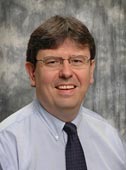Accelerating Fracture Healing

Emil Schemitsch
|
Segmental bone loss at fracture
sites continues to be one
of the most vexing and resistant
problems for orthopaedic
and trauma surgeons. Though
healing can be accomplished
by resection of damaged and
devascularized segments, shortening
the extremity to heal the
fracture in a healthy soft-tissue
envelope results in deformity
that is not generally acceptable to patients. Grafting is
inappropriate in traumatic injuries because of the risk of
infection. Secondary approaches following initial shortening
include the use of distraction frames complemented
with the use of pro-osteogenic factors. About 10% of
traumatic injuries result in segmental defects requiring a
long period of repair. The combination of the injury and
its correction frequently takes a year of the patient's life.
St. Michael's Orthopaedic Division Head Emil
Schemitsch has been working on this problem since he
was an orthopaedic resident at the University of Toronto.
His research project with Robin Richards examined the
effectiveness of muscle flaps to accelerate fracture healing.
He later completed a fellowship in arthroplasty at
Brigham and Women's Hospital in Boston and a trauma
fellowship at Harbourview Hospital in Seattle. When
he returned to Toronto he added bone blood-flow techniques
learned in Seattle to the fracture healing model.
As his study of this problem evolved and deepened,
Emil added molecular and cellular interventions in collaboration
with cardiologist Duncan Stewart. Recent
work with vascular endothelial growth factor in transfected
fibroblasts, and endothelial progenitor cells led
to national and international awards for his advances
toward a solution to this difficult problem.
In studies with Bob Byrick, Emil showed that fat embolism results not from the intramedullary nailing of femoral fractures, but from the initial trauma. More recently, with
|
research engineer Rad Zdero he has applied finite
element modeling to fracture healing in the biomechanics
lab and computer navigation to perfect the positioning
of hip prostheses during resurfacing. Only 2% of
surgeons in North America use computer navigation in
the resurfacing operation. His current resident in the
surgeon-scientist program, Aaron Nauth, is working on
cell-based gene therapy. Aaron has won five grants. Emil
is conducting multi-centre randomized clinical trials on
orthopaedic trauma with his partner Michael McKee,
Mo Bandari from Hamilton and other surgeons across
Canada. The Canadian Orthopaedics Society is a world
leader in orthopaedic randomized clinical trials. Their
recent 1300 patient Sprint trial showed the value of
limited intramedullary reaming for internal fixation of
tibial fractures.
Emil is married to Maureen, a former intensive care nurse
at Sunnybrook. Their daughter Laura is at McMaster.
Their 17-year-old son Geoffrey is billeted in Owen
Sound where he plays for the Owen Sound Attack.
Daughter Christine is at deLaSalle Academy and son
Thomas is a Triple A hockey player for the Northrup
Rangers. There is a lot of hockey commuting in the
Schemitsch family.
During the week of my interview, Emil spent Monday
in the fracture clinic, Tuesday in the operating room performing
two hip resurfacings and one total hip replacement,
Wednesday was spent doing three revision joint
replacements, Thursday in orthopaedic clinic and Friday
chairing a course for community orthopaedic surgeons
at the Hotel Intercontinental. In addition to his research
and busy practice, Emil hopes to strengthen and unify
the practice of arthroplasty surgery in Toronto where
6000 joint replacements are performed each year. He is
grateful to his mentors, principally Robin Richards and
Jim Waddell, and looks forward to mentoring additional
residents in clinical and laboratory research.
See a related story in the Winter 2009 issue of the Spotlight.
M.M. |